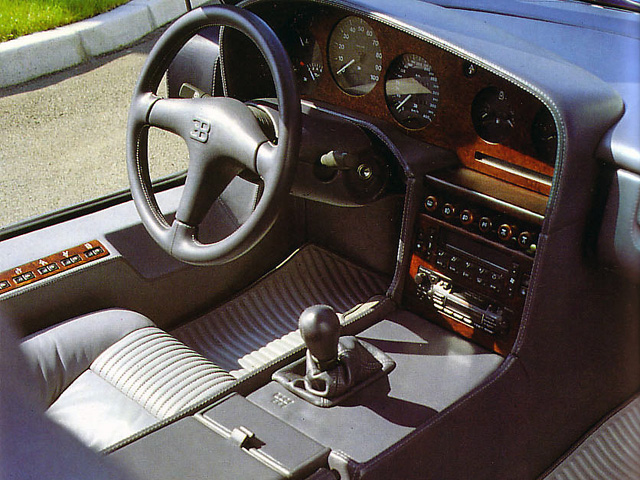1991 Bugatti EB 110 GT Prototype
- Story Cars

- Nov 26, 2021
- 4 min read

The Bugatti name returned in 1991 with the EB110 Gran Turismo The long-deceased Bugatti marque was revived during the early 1990s by Romano Artioli, a wealthy Italian car distributor who acquired the rights to Bugatti's famous name. He planned to launch an all-new model in 1989 with a 60-valve V12 engine, four turbochargers, and at least 550bhp. Full-time four-wheel drive and a six-speed gearbox would also be employed while the target weight was 1300kg. A lavishly funded operation from the outset, Artioli constructed a state-of-the-art factory in Campogalliano, just north of Modena, the global supercar epicenter.
Fabricated from scratch with state-of-the-art componentry, the EB110 GT was launched on September 15th, 1991. Still, Artioli and Bugatti had missed the supercar boom and pitched their stunning new car into a, particularly severe recession. With its distinctive Gandini styling and near £300,000 list price, there just weren't enough buyers for the GT and fewer still for the subsequent £400,000 SS hot rod. So despite the exceptional performance, build quality, and dynamics, the EB110 was a commercial disaster, the Campogalliano factory producing just 126 customer cars before closing down in summer 1995. Incorporating bespoke parts throughout, the GT was based around a hugely advanced and wickedly expensive carbon-fiber tub fabricated by Aerospatiale. The EB110 and McLaren F1 were the only road cars available with composite monocoques during the early nineties, such outlandish features playing an integral part in the huge list prices of each. Bugatti's first five prototypes were completed with chassis fabricated from lightweight aluminum before switching to carbon composite, with eight further prototypes being completed in this state-of-the-art material. The suspension was via independent double wishbones, and with a wheelbase of 2550mm, full-time four-wheel drive, power-assisted steering, and switchable ABS, the GT was eminently predictable in almost any situation. Unique BBS 18-inch magnesium alloy wheels (9 and 12.5-inches wide front/rear) worked with power-assisted cross-drilled and ventilated 322mm brake discs and four-pot Brembo calipers.

Although the GT came out 250kg heavier than had originally been intended (1560kg), it was still incredibly agile and, thanks to its sophisticated all-wheel-drive system, at home in any conditions. The EB110's jewel-like construction continued with a new scratch-built, 3.5-liter V12 engine. Mounted longitudinally, it featured an unprecedented four turbochargers, more than any previous production road car. Fabricated extensively from aluminum and titanium, a displacement of 3499cc was achieved thanks to a bore and stroke of 81 x 56.6mm, respectively.
Bugatti also incorporated an exotic five-valve cylinder head, a technically advanced feature not even used by McLaren's BMW Motorsport engine, let alone Ferrari. Producing an awesome 553bhp at 8000rpm, compression was set at 8.0:1, Bugatti fitting four IHI turbochargers and coupling the engine to a six-speed gearbox. Despite there being noticeable turbo lag below 3500rpm, from this point on, the GT was incredibly quick, and with 451lbft of torque at 3750rpm, its performance was easily accessible. Sprinting to sixty in just 4.4 seconds and taking 9.1 to 100mph, the GT would reach a top speed of 209mph if you could find a quiet enough road. Easily the EB110's most controversial feature, though was not its awe-inspiring performance but bodywork that divided opinion and instantly became something you either loved or hated. Penned by Marcello Gandini, who had famously been responsible for Lamborghini's Miura, Countach, and Diablo, the shell was fabricated from a combination of carbon fiber and aluminum panels bonded to the chassis for ultimate rigidity. Gandini's design failed to captivate in the same way as those aforementioned Lamborghini's, the EB110's awkward headlights lending the car a slightly bizarre appearance. However, with time, it has mellowed, and many favorable features have become apparent. Other exciting details were the trademark Gandini scissor doors used so effectively on the Countach and Diablo, a glass engine cover providing a wonderful view of the V12 engine, and a huge speed-sensitive electronic rear wing that could be raised at the flick of a switch.

Gandini also created the EB110 GT's rather somber cabin that, although fitted throughout with unique componentry, still looked a little downmarket compared to its rivals. Electrically-operated seats were trimmed in leather with ruffled bolsters and ribbed centers, and headrests. The seats themselves were reasonably comfortable but not enveloping enough for such a high-performance car. Like the door trim and center console, they were normally finished in a contrasting shade to the typical black or grey leather-covered dash and steering wheel.
The three-spoke leather steering wheel was sometimes embossed with an EB insignia, fronted by a cheap seventies-looking walnut facia. Visually, access to the oil temperature gauge, tachometer, and speedo was reasonably good. However, rearward vision could hardly be considered up to Porsche standards, and the cabin was cramped for those over six feet. Other interior features included automatic climate control, electronic door releases, and the seating controls on a walnut insert alongside each seat bolster. A set of custom-fitted luggage could be stowed behind the seats. Launched with a lavish celebration held in Versailles during September 1991, the EB110 GT debuted as the world's fastest production car, although the styling was inevitably not to everybody's liking. Road testers heaped praise on the new car's performance and handling, particularly its astounding agility despite the relatively heavyweight. The first customer, EB110 GT, was supplied in December 1991, but Bugatti had long since missed the boom being experienced during its initial announcement. Instead, the EB110 was launched into one of the most severe recessions for decades. Demand for ultra-expensive motorcars had shrunk considerably in just a couple of years. Only well-established marques were able to see out a downturn that continued until the mid-1990s. After completing 95 GT's (all of which were left-hand drives), Bugatti closed its doors in September 1995, having endured the recessions worst years, the company filing for bankruptcy in the Italian courts.
Source: www.qv500.com
Images: Bugatti




























Comments